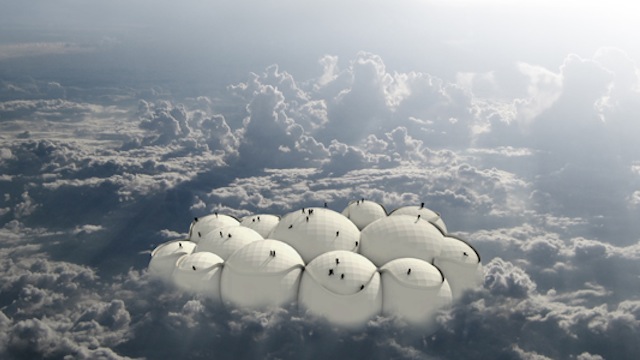Architizer is a blog dedicated to the past, present and future of architectural design. They scour the internet finding the best/coolest/weirdest structures people crawl around in. Their latest find takes inspiration from the inimitable Buckminster Fuller.
The reality of airborne environments, suspended loftily above, amid clouds, has always inhabited our dreams but always exceeded the scope of present technologies, until the twentieth century. Then, several theoretical propositions and experiments were devised, which either failed to get off the ground or came crashing back to it in a ball of fire. But the prospect of taking up residence in the skies may now not only be possible (which it is), but a legitimate ambition, as architect and designer Tiago Barros suggests in his project Passing Cloud, a floating assemblage of zeppelin-like spheres on which passengers stroll for the duration of their travel.
Barros’s cloud formation would be made using tensile nylon fabric stretched taut over a light skeletal steel structure, the whole thing propelled only by gusts of wind. Naturally, this irregular and temperamental source of locomotion would yield incredibly inconsistent time lengths among different trips, thus nullifying the primary virtue of airborne travel, its efficiency through speed.
Given these conditions, passengers about the Passing Cloud would have no need for planning, as they would have little to no influence on the cloud’s direction and speed. Barros frees the traveller from these stressful preoccupations and gives them the opportunity and space in which to explore their ludenic selves. The act of travelling, thus, is redefined and contextualized within a new nomadic vision of life.
Visually, the project is reminiscent of Buckminster Fuller’s “Cloud Nine” project, a theoretical proposal for an airborne habitat whereby several thousand people would be contained housed within the space of mile-wide floating spheres. Polyethelyne would cover a geodesic dome structure, which strengthens as it grows in scale. Fuller asserted that the possibility of these floating cities was contingent on their “recycling and maintaining weight,” by which he meant that the weight of the structure–and everything in it, including buildings–would be negligible compared to the air it enclosed. When this displaced air were heated by only degree higher than the outside air, the structure would rise up into the sky, like a giant hot air balloon.
Each sphere could accommodate a whole city and would, in turn, be connected to others. A cluster of spheres could create giant urban networks, nomadic and travelling over the earth, or tethered to mountains and other natural formations. By modulating the exposure to sunlight, and thus, direct thermal heat, a sphere could be raised and lowered at will. But according to whose authority, exactly?
Republished with permission from Architizer.
Buckminster Fuller and Shoji Sadao, Project for Floating Cloud Structures (Cloud Nine) , 1960.
The exposed geodesic structure of the spheres.
So, how does Cloud City work?
